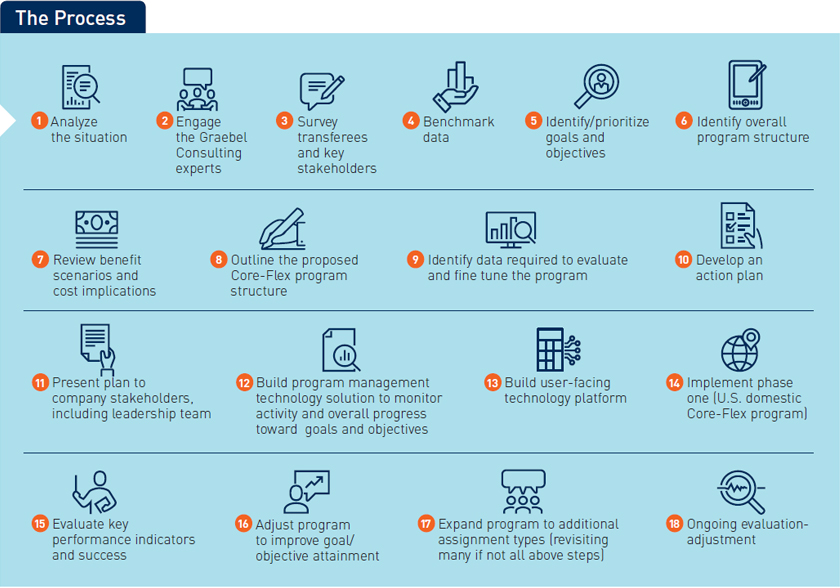Employee Experience Guides Development of Company’s Core-Flex Program

A multinational life sciences company realized that despite its strong culture of putting employees first, its Mobility program wasn’t living up to that standard.
The company averages over 600 relocations each year. Their international assignments (roughly 250) include U.S. inbound as well as transfers to the APAC, EMEA and LATAM regions.
Unfortunately, the company’s Human Resource leaders were increasingly hearing negative feedback from U.S. domestic transferees. The policies were rigid and didn’t always address individual needs. Adding to the urgency, the organization was in the process of acquiring another company that offered relatively generous relocation policies to its transferees.
Challenge:
- Employee feedback on U.S. domestic relocations didn’t match company’s “employee first” culture
- Employees were beginning to resist accepting transfers due to the relocation package
- Company was acquiring another business with a more generous relocation program
Defining the Core-Flex Approach
Core-Flex relocation benefit programs offer personalized relocation packages that combine:
- Core benefits that address compliance requirements and are appropriate for every transferee
- Optional flex benefits that reflect a transferee’s position, personal situation and priorities
A properly structured and well-managed Core-Flex program can produce attractive and relevant packages for employees while reducing the overall program cost.
Listening to the Voice of the Transferee and Key Stakeholders
We were hired to be the company’s relocation management company as these challenges were identified. First, to dig deeper, our Consulting team surveyed recent transferees, asking pointed questions to uncover specific concerns. Our team also met with internal stakeholders to get additional historical context and explored program administrative challenges while revisiting the current program’s guiding principles.
Pulling it all Together
After deliberations and strategic planning sessions with the Mobility team, we meet with the Human Resource leadership team to present our findings and recommendations – which included adjustments to the guiding principles to resolve conflicting goals. Since their international program was newly implemented prior to bringing us on board, the plan was to phase in the U.S. domestic program first, evaluate the progress of the international program and then decide if that segment should be transitioned to a Core-Flex program as well.
The ultimate recommendation was to shift to a U.S. domestic Core-Flex program that:
- Mirrored the positive aspects of their newly formed international transferee program as closely as possible
- Reinforced their employee-focused culture
- Addressed the specific opportunities and concerns uncovered in our analysis
Solution:
- Survey recent transferees to determine specific areas for improvement
- Benchmark industry norms and best practices
- Evaluate various program options and service levels
- Implement a Core-Flex program beginning with the U.S. domestic relocation population
Balancing an Exceptional Employee Experience and Cost
With the leadership’s buy-in with this approach, the building process began in earnest. We led their team through an extended, detailed analysis of the benefit options and scenarios, supported by service level benchmarks from similar-sized companies and other life sciences companies.
While employee experience primarily drove the company’s decisions during this design phase, cost was also a factor. Once the company settled on employee-focused program elements, we conducted a cost analysis that indicated the more individualized U.S. domestic program under development would reduce the cost of each move by 5-10% on average.
Core-Flex Program Implementation and the Path Forward
The new Core-Flex program has been rolled out to non-lump sum U.S. domestic transferees. It has three tiers of core benefits allowing business managers the option to ratchet these up or down depending on employee circumstances. Roughly 50% of the package includes flex benefits, some of which are selected by the business and the rest by the transferee.
Based on initial survey feedback, employees are pleased with the new program and how the company has progressed to add choice and flexibility into the process.
We have identified a regular cycle to monitor the progress, keeping a close eye on program and administrative costs, assignee usage data and, of course, employee experience feedback. If warranted, adjustments to the program will take place during these evaluation periods.
“The company was extremely thorough in exploring all employee options and we were glad to provide data-driven benchmarking and scenario studies to help guide those deliberations and decisions.” – Samantha Hainey, CRP, GMS-T, Vice President, Client Services, Graebel

Results:
- Improved employee feedback for new Core-Flex relocations
- 5-10% per relocation cost savings projected
For more information and guidance on Core-Flex, read these resources:
Four Things to Consider Before You Adopt a Core-Flex Mobility Benefit Program
Guide to Designing a Successful Core-Flex Program